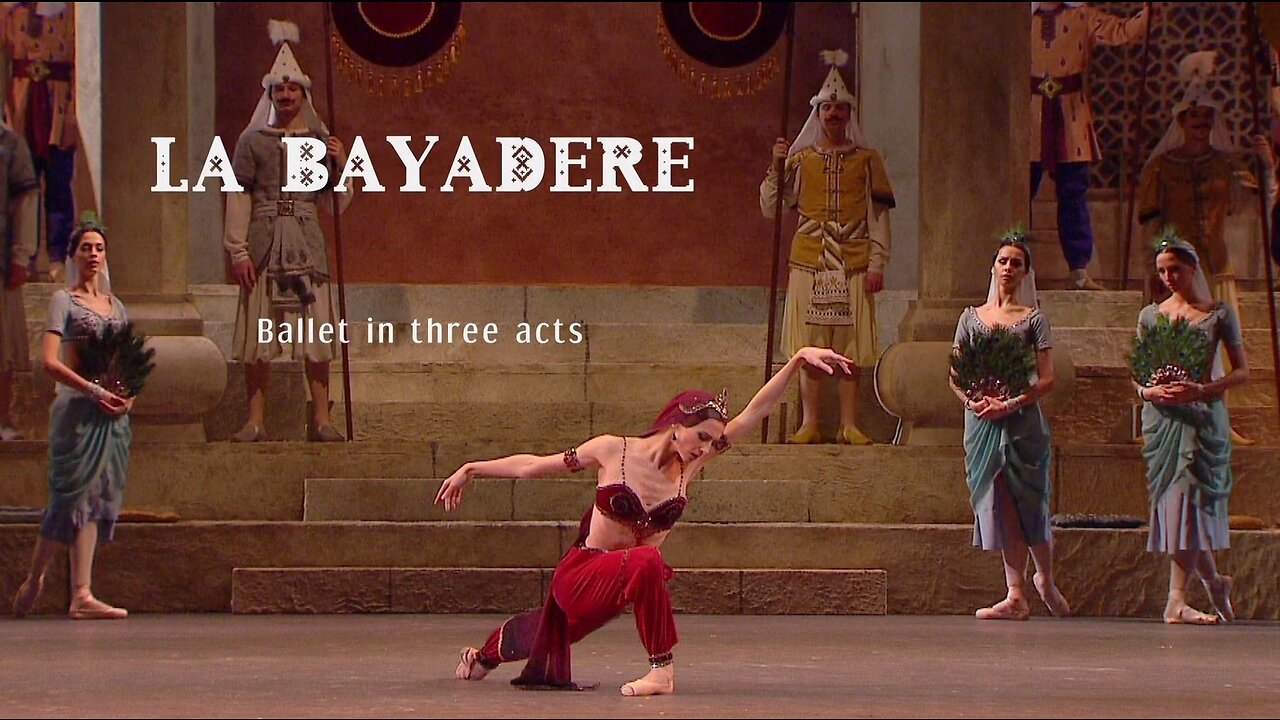Premium Only Content

La Bayadère - Act I (Bolshoi 2013)
Composer: Ludwig Minkus
Librettist/Text Author: Marius Petipa
Librettist/Text Author: Sergei Khudekov
Ballet Company: Bolshoi Ballet
Choreographer: Yuri Grigorovich
Choreographer: Marius Petipa
Cast & Characters:
Nikiya: Svetlana Zakharova
Solor: Vladislav Lantratov
Dugmanta: Alexeii Loparevich
Gamzatti: Maria Alexandrova
Noble Warrior: Vladislav Lantratov
Rajah: Alexei Loparevich
The High Brahmin: Andrei Sitnikov
Corps de Ballet: Bolshoi Ballet
Orchestra: Bolshoi Theatre Orchestra
Conductor: Pavel Sorokin
Television Director: Vincent Bataillon
Lighting Designer: Mikhail Sokolov
Set Designer: Nikolay Sharonov
Costumer Designer: Nikolay Sharonov
La Bayadere is set in ancient India. It is a story of love, intrigue, & betrayal between Solor (the warrior prince), Nikiya (the chosen bayadere), Gamzatti (a princess) and the High Brahmin (spiritual leader of the realm). Yuri Grigorovich's sumptuous recreation of Petipa's choreography, with breathtaking sets and costumes designed by Nikolay Sharonov, stars Svetlana Zakharova as the Bayadere Nikiya, Vladislav Lantratov as Solor and Maria Alexandrova as Gamzatti whose alluring presence challenges Solor's love for Nikiya.
Act 1.Outside the temple. The High Brahmin, monks and servants gather around the sacred fire, just outside the temple, to celebrate the Indian Ritual of Fire. Magadeveya (a trusted servant & fire dancer) and his compaions are summoned by the High Brahmin to light the sacred fire. Temple dancers (Bayaderes) come out of the temple, gather around the fire and dance the Ritual of Fire dance orchestrated by the High Brahmin. After the dance Nikiya, the chosen bayadere (or temple dancer), enters from the temple to dance a solo fire dance. At this point, while the other bayaderes dance around the fire, the High Brahmin confesses his love to Nikiya. Taken back, she refuses his pledge of love. Upset, the High Brahmin ends the Indian Ritual of Fire, He leaves followed by the Bayaderes, monks and servants. Magdeveya stays behind waiting for his master Solor (the warrior prince) to return from a hunt. Solor enters the glen and Magdeveya tells him that Nikiya will return later to meet him. Solor and Magdeveya leave as Nikiya comes back to fill a vase with water from the well. It is at this point Solor returns. They dance and swear their love over the sacred fire. Magdeveya returns to warn them that the High Brahmin will return. At that moment the High Brahmin looks out from the temple and sees the lovers together. Urged by Magdeveya, Nikiya and Solor leave just as the High Brahmin enters. Angered by what he has seen, the High Brahmin swears that someone will pay.
La Bayadère ("the temple dancer") (Russsian: Bayaderka) is a ballet, originally staged in four acts and seven tableaux created by the dramatist Sergei Khudekov and French choreographer Marius Petipa to the music of Ludwig Minkus. The ballet was staged especially for the benefit performance of the Russian Prima ballerina Ekaterina Vazem, who created the principal role of Nikiya. La Bayadère was first presented by the Imperial Ballet at the Imperial Bolshoi Kamenny Theatre in St. Petersburg, Russia, on 4 February [O.S. 23 January] 1877. From the first performance the ballet was universally hailed by contemporary critics as one of the choreographer Petipa's supreme masterpieces, particularly the scene from the ballet known as The Kingdom of the Shades, which became one of the most celebrated pieces in all of classical ballet. By the turn of the 20th century, The Kingdom of the Shades scene was regularly extracted from the full-length work as an independent showpiece, and it has remained so to the present day. Nearly all modern versions of La Bayadère are derived from the Kirov Ballet's production of 1941, which was a severely redacted edition staged by Vakhtang Chabukiani and Vladimir Ponomarev in Leningrad in 1941.
-
 2:46:55
2:46:55
Adaneth - Arts & Literature
1 month agoThe Shakespeare Collection | Romeo and Juliet (S01E01 - BBC 1978)
852 -
 LIVE
LIVE
JdaDelete
8 hours ago $0.09 earnedThe Legend of Zelda: Oracle of Seasons | Part 2
85 watching -
 LIVE
LIVE
LumpyPotatoX2
4 hours agoSub-Sunday with Casual Verdansk - #RumbleGaming
136 watching -
 23:50
23:50
marcushouse
19 hours ago $6.78 earnedStarship Is About to Do Something It’s Never Done Before - A Huge First!
70.7K20 -
 2:35:00
2:35:00
DJC GAME STUDIOS
3 hours ago $0.16 earnedThe Sunday BrUnCh StReAm - LIVE Retro Gaming with DJC
14.3K -
 LIVE
LIVE
FrizzleMcDizzle
5 hours agoElden Ring Seamless COOP
86 watching -
 41:56
41:56
CatfishedOnline
2 days agoKinky Man Sends 401k to Romance Scammer from Ghana!
47.1K16 -
 1:53:55
1:53:55
Nick Shirley
22 hours ago $11.98 earnedIRL Confronting Anti-Trump & Anti-Elon Protesters
57.6K164 -
 16:18
16:18
Tactical Advisor
1 day agoRetiring My Patrol Rifle | Old vs New
46K3 -
 22:29
22:29
JasminLaine
23 hours agoAwkward Silence After Poilievre FACT CHECKS Reporter—Carney’s Face SAYS IT ALL
43.5K51